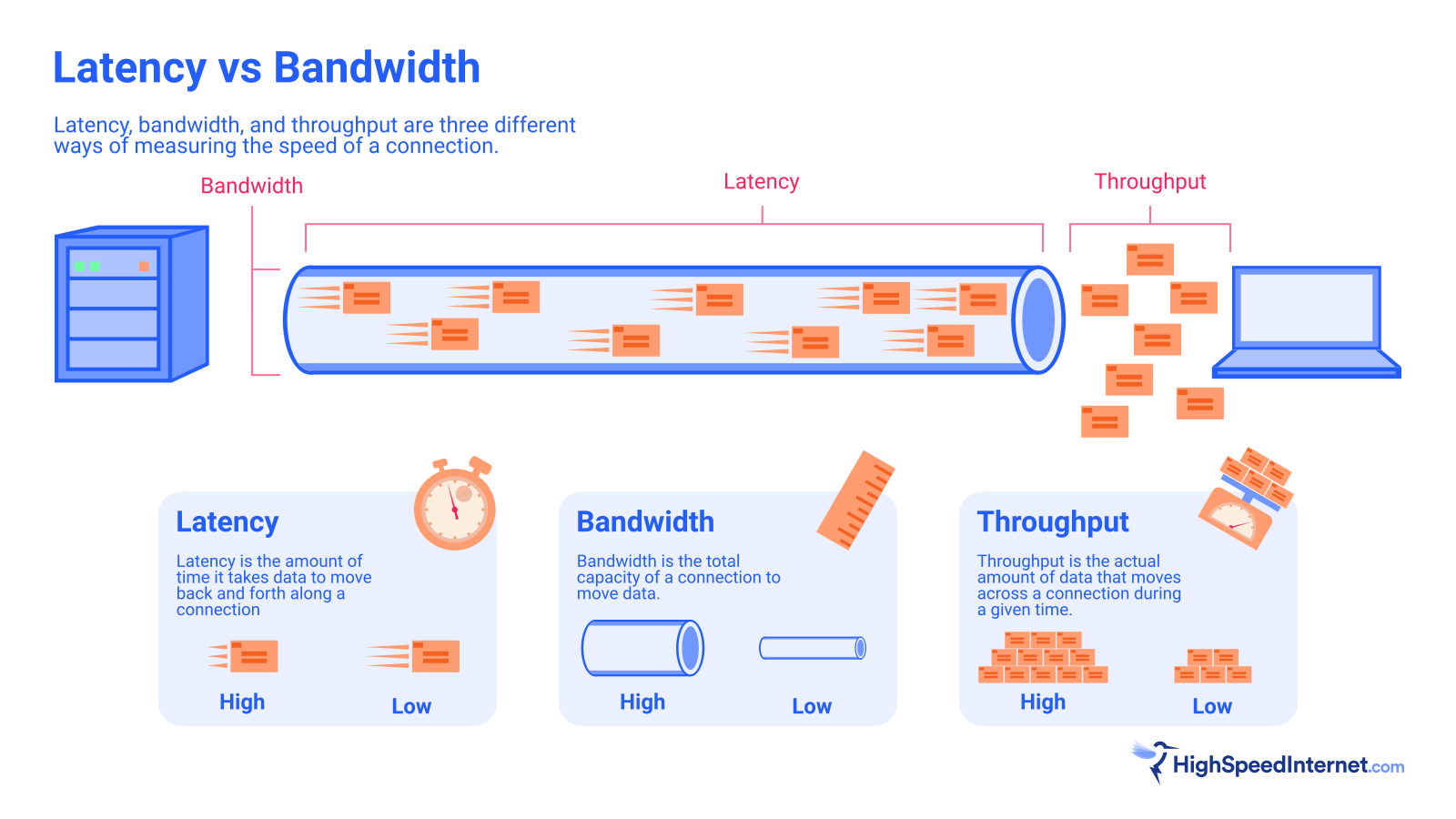How To Make Your Internet Better for Gaming
Hint: It’s not about download speed.
Jan 27, 2025 | Share
Brand Guides
Nothing says “Time to upgrade your internet” quite like getting booted from an online game due to lag. While it might be tempting to immediately run out and get the fastest plan on the market, lag is generally caused by high latency, not low download speed. There are a lot of good choices for low-latency internet plans, but there are also a lot of other tricks you can try first to reduce your latency when playing online.
Online games can get by on low bandwidth
Playing video games has always been a hardware intensive activity. I don’t know anyone who ever had to upgrade their computer to run the upcoming version of Microsoft Word, but this was almost a right of passage for players of games like Doom and Unreal Tournament. Video games have always pushed the limits of hardware—pioneering technologies like 3D graphics, haptic feedback, and AI.
It might be surprising to those who know this history of video games and technology that even the most intense modern games don’t actually require a very fast internet connection—or at least not the kind of fast connections internet providers talk about.
Most online activities depend on moving a lot of data really fast. If you want to watch a movie on Netflix, the app has to download a high-definition (or 4K) image 30 times per second plus any associated sound. That’s a lot of data moving through your internet connection.
If you want to move a lot of data over a connection, you need bandwidth. Bandwidth (or download speed) is the capacity of a connection to carry data, usually measured in bits (or megabits, gigabits, etc.) per second. If you want your movie to playback smoothly without buffering, your connection needs to have enough capacity to keep that data flowing constantly.

In contrast, the only information your game console needs to know is what buttons the other players just pressed. You still get to experience amazing visuals and sound, but they’re generated by the console itself instead of being piped in over your internet connection (RIP Google Stadia…).
Even though the information going back and forth over your internet connection might be smaller than a single text message, it’s important that it’s able to make this journey quickly. This is where latency comes in.
Online games need low latency
Latency is the amount of time that it takes for a signal to travel from your device to a remote server, such as a game server, and back to your device. You can test your latency by sending a single “ping” of information to a remote server and timing how long it takes until that signal comes back. This is why latency is often referred to as “ping” or “ping rate.”
Connections with a faster download speed usually have lower latency, but that’s not always the case. Geosynchronous (GSO) satellite connections are notorious for their very high latency but can also have higher download speeds than other wireless plans and even wired connections like DSL.
For video games and other real-time activities, latency is much more important than bandwidth. It’s a bit like urgently ordering a new air conditioner during a heat wave. It doesn’t matter if Amazon delivers ten other packages to your doorstep every day if the specific package you’re waiting for takes two weeks to arrive.
Pro tip
When playing online games, latency or ping helps players understand how fast their device is communicating with the game server. Ping requirements vary from game to game, but here’s a general range to judge your connection:
- Less than 20ms: Excellent! You can’t get any better than this.
- 20ms–50ms: You shouldn’t experience any lag.
- 50ms–100ms: You might experience the occasional lag, but nothing that should cause you any major issues.
- 100ms–150ms: You will probably experience frequent lag, which could interfere with playing the game.
- 150ms and above: Unacceptable. Once you get above 150ms of latency, your connection to the game can become unstable and you may get disconnected. It’s difficult or impossible to play real-time games with this amount of latency.
Modern games have a lot of tricks to deal with differing amounts of latency between players and avoid lag, but if another player has been shooting at you for a full 2 seconds and the game still doesn’t know if you ducked or not, it’s going to cause problems. If your latency is just a bit too high, you might deal with sluggish controls, delayed reactions, and jerky movements. If it’s even higher, the game will likely just kick you out.
As mentioned, latency isn’t usually the focus of internet providers, so it can be difficult to troubleshoot latency issues when you have them. Fortunately, there are some steps you can take to make your internet connection better for playing online games:
- Connect via an Ethernet cable.
- Choose the nearest game server.
- Reduce traffic on your home network.
- Restart your router.
- Upgrade your router.
- Upgrade your internet plan.
We’ll walk you through each of these steps to help you keep your online games lag-free.
Connect via Ethernet
Most of the latency in an internet connection comes from traveling the huge distances between your home and the remote server, however, some of that latency can come from the way you set up your home network. While Wi-Fi is generally pretty fast, it does take time for your router to take the signal entering your house, convert it into a wireless signal, broadcast that signal to your device, and then have your device turn it back into an electrical signal.
Even though these steps take only milliseconds, that can sometimes be too much of a delay. Additionally, if your router is set up in a less-than-ideal location, it can increase the number of data packets that are lost during transmission, further slowing down the time it takes to get information back and forth.
Using a physical ethernet cable will always be at least slightly faster than connecting over Wi-Fi, and it’s also much more stable. If you’re having issues with lag in the games you’re playing, plugging your console or computer into your router is a cheap and easy way to improve your connection.
Choose the nearest server
The biggest determiner of latency is the distance between you and the server of the game you’re playing. Most big online games will have servers set up around the world and will always connect you to the nearest one by default. You can often switch servers manually in order to play with a different pool of other players, but doing so could cause some serious lag.
This isn’t as much of a common problem as it is a facepalm moment when you realize why you’ve been dealing with lag for a couple of weeks. If the lag in your games has gotten worse, especially if the problem is in one specific game, it’s worth checking to make sure that you’re not connecting to the Asia/Pacific server when you live in Baltimore.
Reduce network traffic
Sometimes the problem with your home network isn’t your router. Well, at least not directly.
Even if you have a great internet connection, your router can still be a bottleneck for latency (and bandwidth) if your home network has more traffic than your router can deal with. Older routers can easily be overwhelmed if there are too many devices on the network demanding limited resources. If there are several other devices streaming video while you’re trying to play a game, the router might have to interrupt its connection to your console in order to send incoming data to those other devices.
Most modern routers are designed to handle lots of connected devices at the same time, but it’s still a good idea to avoid activities like downloading updates or streaming video while you’re trying to play games online.
Fix your router’s settings
If you suspect that your router is the source of your latency issues, the first step, as usual, is to reset your router by turning it off and then turning it back on again. It’s a very obvious solution, but it’s surprising how often that fixes your problem.
After you’ve tried resetting your router, there are still ways that you can improve its performance when playing online games. Many routers offer quality of service features that allow you to prioritize certain devices or programs so that they don’t get interrupted by other traffic on your network. These settings are usually accessed through your router’s admin page and will be listed under “QoS” or some similar title.
There are a few other tricks you can try to improve your home network performance. For example, if you’re in an apartment building or another densely populated area, you can change your router’s wireless channel from the admin page to reduce interference from other nearby Wi-Fi networks, though it’s usually better to just use an Ethernet cable if possible.
These small optimizations also assume that your router is working properly to begin with. If your router has problems with normal internet activity, you should troubleshoot those issues first before trying to optimize your network for gaming. If all else fails, you can try performing a full factory reset on your router, or it might just be time for a new router.
Get a better router
Routers aren’t the flashiest bits of tech on the market, but they have made some pretty big improvements in recent years. In particular, most new routers use the Wi-Fi 6 standard, which not only improved speeds, but also introduced technologies to better manage network congestion, especially in smart homes with dozens of connected devices.
There are, of course, plenty of excellent gaming routers out there designed specifically with tools to help you get the most out of online games. There are also plenty of budget options for routers which may not be the most cutting edge devices, but are still a big improvement over an old router running Wi-Fi 4 technology.
It’s important to remember that while a bad router can definitely add to your connection’s latency, a good router can’t reduce the base level of latency that comes with your internet connection. If you struggle to play online games with your current connection, upgrading to a different connection type that has lower latency is the best way to improve your online experience.
Get a better internet plan
Certain types of internet connection inherently suffer from high latency. GSO satellite is the worst offender with a minimum latency of around 600ms. Low-Earth orbit (LEO) satellites and other types of wireless internet fare much better, but they still tend to be on the high end of latency. The lowest-latency connections are fiber, which makes sense, since the bulk of internet infrastructure is built from fiber already.
The nice thing about looking for a low-latency fiber connection is that even slower fiber plans still have incredibly low latency, so you don’t need to sign up for the most expensive multi-gigabit fiber plan to have a great setup for online gaming.
Popular fiber internet providers
| Provider | Price | Speed | Get it |
|---|---|---|---|
|
| $70.00–$150.00/mo.* | 1,000–8,000Mbps | View Plan |
| $55.00–$250.00/mo.† | 300–5,000Mbps | ||
|
| $49.99–$94.99/mo.‡ | 300–2,000Mbps | View Plan |
| $30.00–$75.00/mo.§ | 200–1,000Mbps |
Data as of 1/27/2025. Offers and availability may vary by location and are subject to change.
*Plus taxes and fees. Upload/download speed and device streaming claims are based on maximum wired speeds. Actual Internet speeds are not guaranteed and may vary based on factors such as hardware and software limitations, latency, packet loss, etc. 5Gbps and 8Gbps plans available in select markets only.
†Price after $5/mo Autopay & Paperless bill discount (w/in 2 bills). Plus taxes & fees. Monthly State Cost Recovery Charge in TX, OH, NV applies. Ltd. availability/areas.
‡Price per month with Auto Pay & without select 5G mobile plans. Fios plan prices include taxes & fees. 2 Gig plan Available in select areas only.
§Speed may not be available in your area. Maximum download/upload speed of up to 940 Mbps via a wired connection. Paperless billing required. Taxes and fees apply. Offer details. Offer includes professional installation at customer’s eligible location
If you don’t have a fiber provider in your area, cable internet is the next best choice for a low-latency connection, followed by DSL.
More resources
Looking for more information about how to get the best internet connection for playing online games? Check out these other articles from our internet experts.
Author - Peter Christiansen
Peter Christiansen writes about telecom policy, communications infrastructure, satellite internet, and rural connectivity for HighSpeedInternet.com. Peter holds a PhD in communication from the University of Utah and has been working in tech for over 15 years as a computer programmer, game developer, filmmaker, and writer. His writing has been praised by outlets like Wired, Digital Humanities Now, and the New Statesman.





